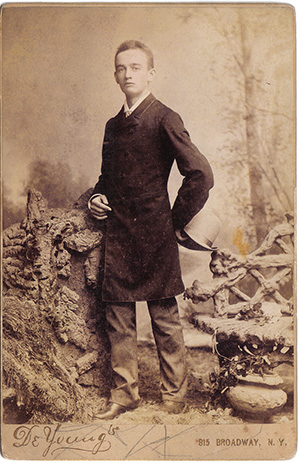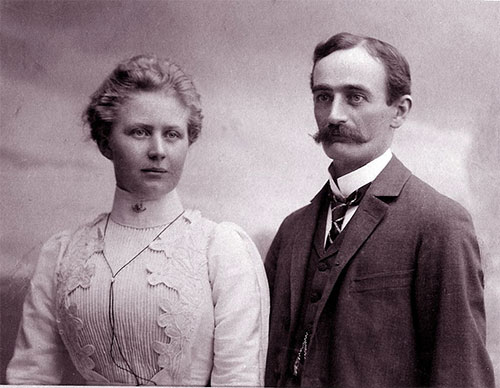
Trump’s grandfather took part in the Gold RushEntrepreneur had hotels in Bennett, WhitehorseBy DAVE KIFFERNovember 25, 2016
It is clear that the fortune that would eventually help propel Frederick Trump’s grandson to the Presidency of the United States had its beginnings in the late 1890s when Trump, a German immigrant, moved to the Klondike, not to mine for gold, but – to use a term common in mining communities – to mine the miners. Frederick Trump came to the United States as a 16-year-old in 1885 from the town of Kallstadt in the Rhineland-Palatinate area of Bavaria which is in the southwest part of what is now unified Germany Although the Trump family says that Frederick Trump was seeking economic improvement, recent stories in the German magazine Bild have uncovered documentation indicating that the real reason may have been that Trump was kicked out of Germany for failing to undergo the required military service in Bavaria. Later when Frederick Trump tried to return permanently to Germany in 1905, the government turned down his request and ordered him deported back to the United States, according to Bild. 1905 was also when Frederick’s son – Donald Trump’s father – Frederick Trump Jr. was born in New York. Frederick Trump Jr. would expand the family fortune through extensive real estate holdings in New York. According to most historians, Frederick Trump Sr. spent six years in New York City working as a barber and living with his sister and brother-in-law. In 1891, he decided to head west to seek his fortune, eventually ending up in Seattle. He opened a restaurant in either the Skid Row or the Lava Bed sections of Seattle. Historians disagree on the location, although most believe it was on Washington Street. That restaurant, which also doubled as a barber’s shop was called the Dairy Restaurant, according to an October, 2016 story by Jason Marcusoff in Canada’s Macleans magazine. At some point, Trump purchased 40 acres of land in the Pine Lake Pines area east of Seattle. It was the first real estate deal for a family that would be known for its real estate holdings for generations to come. The historical record soon finds Trump applying for a small mining claim in the mining boom town of Monte Cristo, some 50 miles northeast of Seattle. Monte Cristo was thought to be one of the greatest lead and silver deposits on the continent, but did not live up to projections. Meanwhile Trump made a foray into local politics and was reportedly elected Justice of the Peace by a 32-5 margin. By 1896, most of the mining in Monte Cristo had stopped and, along with most of the other miners, Trump had returned to Seattle and opened another restaurant. He was apparently still there when word reached Puget Sound of the Klondike gold strike near Dawson in the Yukon territory in the summer of 1897. Marcusoff writes that Frederick Trump immediately sent two associates north to stake two $15 claims on Hunker Creek near the Bonanza claim on the Klondike. The men did just that but then immediately sold those claims, later valued at tens of thousands of dollars, for $400 each. “It was uncertain whether they were two cents’ worth, let alone two million,” Yukon historian Michael Gates told Macleans. “Had they held it, these Washington-state miners and Trump could have made vastly more than they did. Hunker Creek claims panned out—yep, that’s where the phrase comes from—as one of the most productive creeks in the gold rush.” But Alaskan writer/historian Dermot Cole noted in the Alaska Dispatch News in 2015 that a book written in 1896 and recently republished somewhat confuses the issue on whether or not Frederick Trump was involved in actual mining in the Yukon. “Two Years in the Klondike and the Alaska Gold Fields” by William Haskell relates the story of a man named “Fred Trump” who either earned a fortune in cold or just missed it, according to Cole. He noted that it could also be a case of mistaken identity. In 1895, “Fred Trump” apparently went down the Yukon from Dawson to Circle City in Alaska and tried to sell a claim on Hunker Creek for $2,000. He found no takers.
Elizabeth Christ & Frederick Trump, 1918
To this day, it is unclear whether the “Fred Trump” referred to in the 1896 book is the same Fred Trump, the grandfather of the President-elect, Cole wrote. Meanwhile, other historians note that in March of 1898, Frederick Trump sold his Seattle restaurant and boarded the vessel Humbolt for Skagway. By then, word had begun to filter out that most of the good Klondike claims had been staked and Trump looked for other ways to profit from the rush. According to a 2012 story in the London Daily Mail, he partnered up with another man named Ernest Levin and opened a small restaurant in a tent along the “Dead Horse” trail on the White Pass north of Skagway. The trail got its name from the more than 3,000 pack animals that died there during the rush. The Mail claims that Levin and Trump were “offering up hot simple meals to the constant stream of prospectors passing through, with horsemeat one of their best sellers.” Within a couple of months, Trump and Levin had moved their operation to a more permanent locale, the town of Bennett (sometimes referred to Bennett City), just over the White Pass in Canada, where the Stampeders gathered to build boats for the river journey to Dawson City. Trump and Levin built a two-story structure called the New Arctic Restaurant and Hotel which stood out amongst the thousands of tents that made up most of Bennett. "In the larder was salmon and an extraordinary variety of meats, including duck, ptarmigan, grouse, goose, and swan, as well as caribou, moose, goat, sheep, rabbit, and squirrel,'" Gwenda Blair wrote in her 2001 book ‘The Trumps: Three Generations that Built an Empire.’ “'Incredibly, the New Arctic served fresh fruit: red currants, raspberries, strawberries, blueberries, blackberries, even cranberries. A small oasis of luxury, the Arctic’s menu was a vast improvement over what the two restaurateurs had been able to offer on the trail." Taking out advertisements in the Bennett Sun newspaper, Trump noted that the Arctic was the “best equipped restaurant in Bennett, all modern improvements, every delicacy in the market served, the cuisine under the management of a scientific chef.”
Portrait of the Trump family, from left to right: Fred, Frederick, Elizabeth, Elizabeth Christ, and John, 1915
A letter in the Yukon Sun newspaper in 1897 contained the following: "For single men, the Arctic has excellent accommodations as well as the best restaurant in Bennett, but I would not advise respectable women to go there to sleep as they are liable to hear that which would be repugnant to their feelings – and uttered, too, by the depraved of their own sex.” Earlier this year, in response to stories about the Artic Hotel in the national media, Donald Trump called “completely false” any stories that any hotels run by Frederick Trump were “brothels.” But, as with all gold rush towns, change – in the form of a railroad between Skagway and the Yukon brought change to Bennett. Trump relocated the Artic Restaurant to Front Street in Whitehorse. “The Klondike rush had begun its decline by the time New Arctic began in Bennett, but a train close to completion all the way from the port at Skagway, to Whitehorse would outright kill Bennett and its businesses. “Macleans reported in 2016. “Trump and Levin set their restaurant’s frame on a raft toward Whitehorse so it could open in time for the White Pass & Yukon Route’s opening in summer 1900. With a wood-framed tent and a false façade, the Arctic Restaurant opened up across Front Street from the terminal.” But the New Artic Restaurant and Hotel faced competition in Whitehorse from larger and more fancier establishments. Trump took out advertisements in the Whitehorse Star promoting the Artic as “newest, neatest and best-equipped north of Vancouver,” In a 2015 story about the Artic, the Canadian history website “Up Here” noted that the new Arctic s was open 24/7 and that 3,000 meals a day were served and miners and women of “loose morals” were cavorting inside its rooms. In another ad in the Whitehorse Star, Trump and Levin noted the Artic “was here to stay.” But within a few months, Trump had left the business. According to the Daily Mail, Trump and Levin were having trouble, mostly due to Levin’s drinking and gambling, popular pastimes in the booming Whitehorse. Levin was soon in deep debt. “After just over three years in the north, Trump, again ahead of the curve, cashed in and shipped out, as stampeders fled the area in droves,” The Mail wrote in 2012. “After the Arctic's success, Trump left as a respectable businessman.” Trump left the Klondike with more than $500,000 in today’s dollars, more than enough to establish his family and begin the family fortune that would facilitate Donald Trump’s rise to the White House. Meanwhile, back in Whitehorse, Levin’s trouble’s continued. He lost control of the Arctic in 1902 and went to jail after a reported “orgy” and jewelry theft took place, according to Macleans. The population of Whitehorse, which peaked at 27,000, was under 10,000 by the end of the decades and the Arctic had burned down in the Great Whitehorse Fire of 1905. The location is now the site of the Horwood Mall which contains boutiques and restaurants but there is little in Whitehorse to commemorate the Trump family’s time in the community. Things may be a little different, though, in the old ghost town at Bennett. The only structure remaining from the gold rush days is a large wooden church that is vacant, but the Carcross-Tagish First Nations and Parks Canada is hoping to create a “high end 'glamping' experience with tent style cabins and a recreated restaurant for those shelling out $1,600 for four nights to stay at the Chilkoot Trail Village.” The centerpiece of the village will be a replica of the “famous Artic Restaurant and Hotel that was the place to be at Bennett City during the Klondike Gold Rush of 1898” according to the Nature Tours Yukon website. Nature Tours plans to market the 'glamping experience.' The new development was planned long before the recent American presidential election and the Trump Organization is not currently involved. But it is hard to imagine that a future development in Bennett will not include at least a nod to the family history of the 2016 President-elect.
Contact Dave at dave@sitnews.us Dave Kiffer ©2016
Publish A Letter in SitNews Read Letters/Opinions
|
|||


